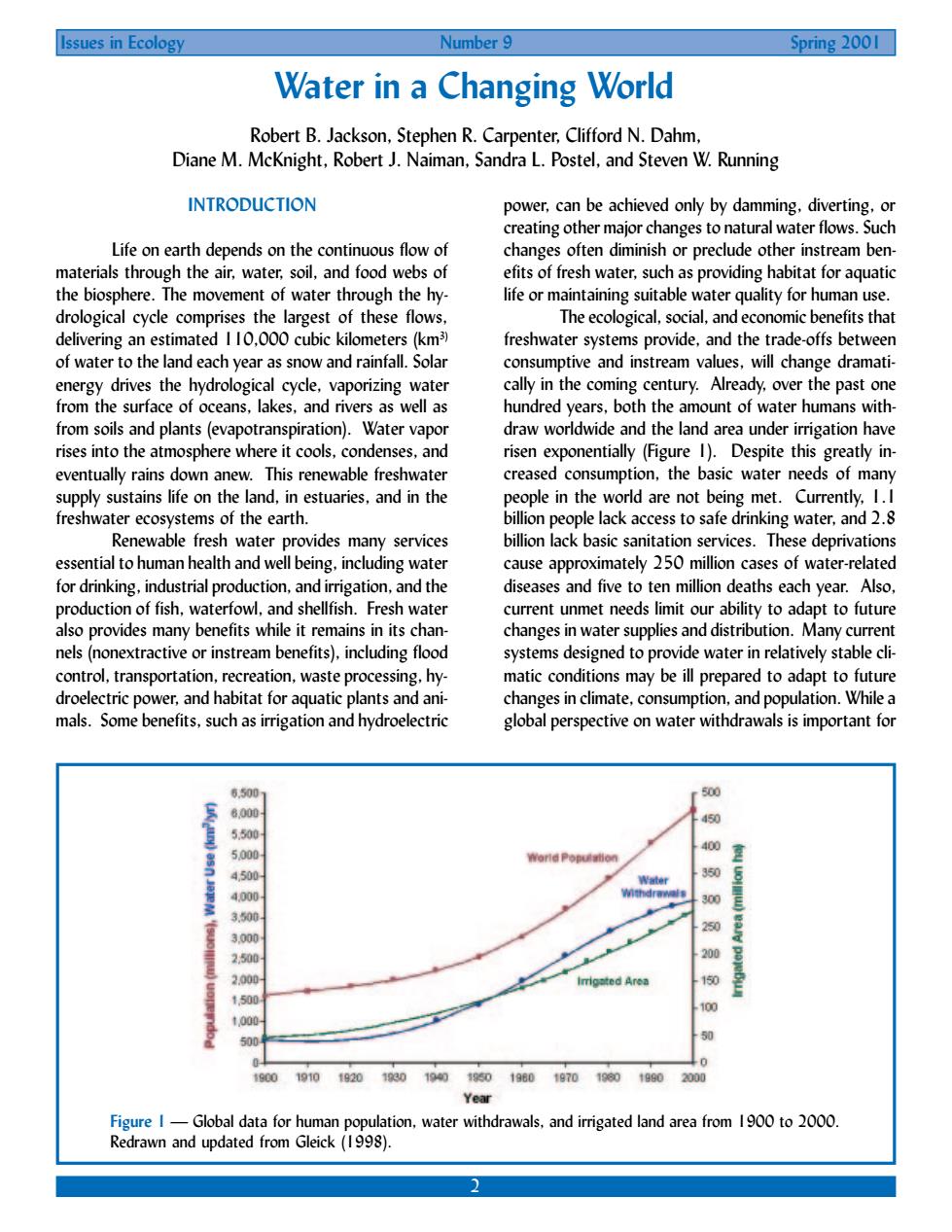正在加载图片...

Issues in Ecology Number 9 Spring2001☐ Water in a Changing World Robert B.Jackson,Stephen R.Carpenter,Clifford N.Dahm, Diane M.MeKnight,Robert J.Naiman.Sandra L.Postel,and Steven W.Running INTRODUCTION power,can be achieved only by damming.diverting.or creating other major changes to natural water flows.Such Life on earth depends on the continuous flow of changes often diminish or preclude other instream ben- materials through the air,water.soil,and food webs of efits of fresh water.such as providing habitat for aquatic the biosphere.The movement of water through the hy life or maintaining suitable water quality for human use drological cycle est of these Theecological, cono mic be efits tha delivering an estim neters (km reshwater ystems provide.and the trade-offs between of water to the land each year as snow and rainfall.Solar consumptive and instream values,will change dramati energy drives the hydrological cycle,vaporizing water cally in the coming century.Already,over the past one from the surface of oceans,lakes,and rivers as well as hundred years,both the amount of water humans with- from soils and plants (evapotranspiration).Water vapor draw worldwide and the land area under irrigation have rises into the atmosphere where it cools,condenses.and risen exponentially (Figure 1).Despite this greatly in hwate ad sumption the basic water eds of rld are not b eing met Currently, Renewable fresh water provides many services billion lack basic sanitation services.These deprivations essential to human health and well being.including water cause approximately 250 million cases of water-related for drinking.industrial production,and irrigation,and the diseases and five to ten million deaths each vear.also ent unmet needs limit our ability to adapt to future ch- s in ate supplies and distribu ion.Many nels nextractive or instream benefits).including flood systems des signed topr control,transportation,recreation.waste processing.hy- matic conditions may be ill prepared to adapt to future droelectric power,and habitat for aquatic plants and ani- changes in climate,consumption,and population.While a mals.Some benefits,such as irrigation and hydroelectric global perspective on water withdrawals is important for 00 45 400 30 2 20 1901p01920019001601701602000 Year Figure I-Global data for hum pulation.water withdrawals.and irrigated land area. Redrawn and updated rom Gleick()2 Issues in Ecology Number 9 Spring 2001 Robert B. Jackson, Stephen R. Carpenter, Clifford N. Dahm, Diane M. McKnight, Robert J. Naiman, Sandra L. Postel, and Steven W. Running Water in a Changing World Figure 1 — Global data for human population, water withdrawals, and irrigated land area from 1900 to 2000. Redrawn and updated from Gleick (1998). INTRODUCTION Life on earth depends on the continuous flow of materials through the air, water, soil, and food webs of the biosphere. The movement of water through the hydrological cycle comprises the largest of these flows, delivering an estimated 110,000 cubic kilometers (km3) of water to the land each year as snow and rainfall. Solar energy drives the hydrological cycle, vaporizing water from the surface of oceans, lakes, and rivers as well as from soils and plants (evapotranspiration). Water vapor rises into the atmosphere where it cools, condenses, and eventually rains down anew. This renewable freshwater supply sustains life on the land, in estuaries, and in the freshwater ecosystems of the earth. Renewable fresh water provides many services essential to human health and well being, including water for drinking, industrial production, and irrigation, and the production of fish, waterfowl, and shellfish. Fresh water also provides many benefits while it remains in its channels (nonextractive or instream benefits), including flood control, transportation, recreation, waste processing, hydroelectric power, and habitat for aquatic plants and animals. Some benefits, such as irrigation and hydroelectric power, can be achieved only by damming, diverting, or creating other major changes to natural water flows. Such changes often diminish or preclude other instream benefits of fresh water, such as providing habitat for aquatic life or maintaining suitable water quality for human use. The ecological, social, and economic benefits that freshwater systems provide, and the trade-offs between consumptive and instream values, will change dramatically in the coming century. Already, over the past one hundred years, both the amount of water humans withdraw worldwide and the land area under irrigation have risen exponentially (Figure 1). Despite this greatly increased consumption, the basic water needs of many people in the world are not being met. Currently, 1.1 billion people lack access to safe drinking water, and 2.8 billion lack basic sanitation services. These deprivations cause approximately 250 million cases of water-related diseases and five to ten million deaths each year. Also, current unmet needs limit our ability to adapt to future changes in water supplies and distribution. Many current systems designed to provide water in relatively stable climatic conditions may be ill prepared to adapt to future changes in climate, consumption, and population. While a global perspective on water withdrawals is important for